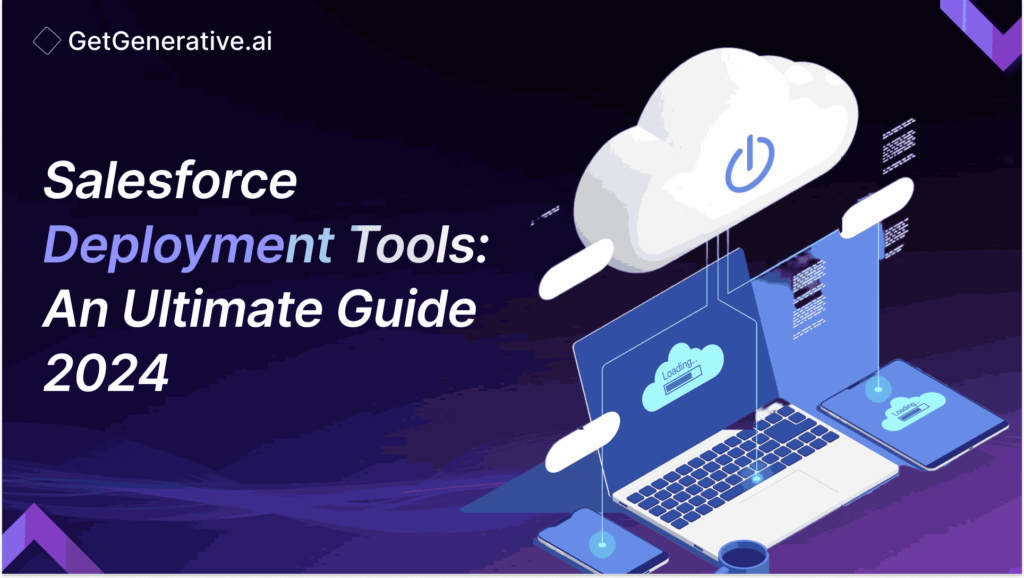Salesforce Deployment Tools: An Ultimate Guide 2024
Salesforce is a powerful CRM platform that centralizes a company’s interactions with customers, encompassing data, sales, and marketing efforts. Salesforce deployment tools are continuously evolving, becoming more sophisticated and efficient with each passing year. In 2024, these tools will be better equipped to handle the complexities of growing businesses and multiple environments, such as production and testing.
This guide delves into the main Salesforce deployment tools available in 2024, highlighting their features, benefits, and drawbacks. We also explore third-party deployment tools like Copado and Gearset.
Popular Salesforce Deployment Tools in 2024
With technology advancing rapidly, the tools for deploying Salesforce are also improving. Here’s a look at some of the most popular Salesforce deployment mechanisms in 2024:
- Salesforce Change Sets
- Salesforce Packages
- Salesforce DX
- Salesforce Metadata API
- Salesforce ANT Migration Tool
- Salesforce Data Loader
- Salesforce AppExchange
- Salesforce CLI
1. Salesforce Change Sets
Salesforce Change Sets remain a popular choice for deploying changes between Salesforce environments. They are particularly useful for moving changes from production to sandbox environments. Key benefits include ease of use, minimal setup, and the ability to track changes and monitor deployment progress. However, they do not support the deployment of certain components like Apex classes and Visualforce pages.
2. Salesforce Packages
Salesforce Packages allow for the deployment of code and metadata changes across different orgs. There are two types: Unmanaged and Managed Packages. Unmanaged packages are free and open for anyone to install. In contrast, Managed Packages, which can be free or paid, offer additional perks such as tracking changes and rollback capabilities. Challenges include difficulty in transferring ownership and restricted installation privileges for managed packages.
3. Salesforce DX
Salesforce DX is a cloud-based development platform streamlines building, testing, and deploying applications. It supports version control, automated tests, and collaboration on real-time projects. Its scalability and adaptability make it a powerful tool, though it requires some technical knowledge to leverage effectively.
4. Salesforce Metadata API
The Metadata API is a robust tool for managing Salesforce org metadata, including customizations and configurations. It allows for deploying changes between multiple orgs and automating common tasks. While powerful, learning can be challenging and unavailable in all Salesforce editions.
5. Salesforce ANT Migration Tool
The ANT Migration Tool is designed to deploy Salesforce code and metadata between organizations. It uses the Metadata API and is suitable for both on-premises and cloud-based environments. Users should be familiar with the command line to operate this tool effectively.
6. Salesforce Data Loader
Salesforce Data Loader is a desktop application ideal for handling large volumes of data. It supports operations like loading, updating, deleting, and extracting data using CSV files. It’s a free tool that excels at managing extensive data operations.
7. Salesforce AppExchange
AppExchange is a marketplace for pre-built Salesforce applications and add-ons. It allows businesses to find solutions tailored to their needs, reducing the time to market. Applications on AppExchange cater to a wide range of business requirements.
8. Salesforce CLI
Salesforce CLI is a command line interface that automates various development processes, including data retrieval, code deployment, and unit tests. It integrates seamlessly with IDE tools like VSCode, enhancing its utility for developers.
Best Practices for Salesforce Deployment
Effective Salesforce deployment requires careful planning, testing, and execution. Here are some best practices to enhance efficiency and minimize disruptions:
- Develop a Deployment Plan: Outline the scope of changes, schedule, roles, and rollback plans.
- Use Version Control: Track changes and facilitate collaboration with a version control system.
- Leverage Sandboxes: Test changes in a sandbox environment to avoid affecting live data.
- Automate Deployments: Use tools like Salesforce DX and Jenkins to automate deployment stages.
- Perform Incremental Deployments: Deploy changes incrementally to monitor impacts closely.
- Use Metadata API for Complex Deployments: Handle complex deployments with the flexibility of Metadata API.
- Adopt a Testing Strategy: Implement unit, integration, and user acceptance testing (UAT) tests.
- Communicate with Stakeholders: Keep stakeholders informed about deployment schedules and impacts.
- Monitor Post-Deployment: Monitor the system for issues post-deployment and have a quick response plan.
- Document Everything: Maintain detailed documentation of processes, changes, and issues.
Also Read – Einstein Generative AI Features Across Salesforce Clouds – The Ultimate Guide
Third-Party Salesforce Deployment Tools
Numerous third-party tools enhance Salesforce deployment processes, offering features beyond native tools:
- Copado: Provides a comprehensive DevOps solution with continuous integration, delivery, and automated testing.
- Gearset: Known for its user-friendly interface and features like automated deployments and change monitoring.
- Flosum: An all-in-one Salesforce DevOps solution with version control and rollback capabilities.
Conclusion
Salesforce deployment tools in 2024 offer a range of features to manage customer relationships and business operations effectively. The right tool depends on your organization’s specific needs, but understanding each tool’s strengths and limitations is crucial for making an informed decision.
By following best practices and leveraging native and third-party tools, businesses can ensure smooth and efficient Salesforce deployments, enhancing productivity and profitability.
Enhance your Salesforce consulting with GetGenerative.ai. Effortlessly craft outstanding proposals, enabling you to dedicate more time to providing exceptional client service.
Start today!
Frequently Asked Questions (FAQs)
1. What are the benefits of using Salesforce deployment tools?
Streamline change management, reduce deployment errors, automate tasks, and provide version control for tracking changes.
2. What are the challenges of using Salesforce deployment tools?
Some tools require technical expertise, may have limitations on deployable components, and can be slow in large organizations.
3. How do I choose the right Salesforce deployment tool?
Consider your organization’s size, deployment complexity, team’s technical skills, and budget.
4. How do I set up a Salesforce deployment tool?
Follow specific guides for each tool involving installation, connection to Salesforce org, and configuration.
5. How do I deploy changes to Salesforce using a deployment tool?
Changes can be made in a development environment, packaged, and deployed to the target environment using the selected tool.




